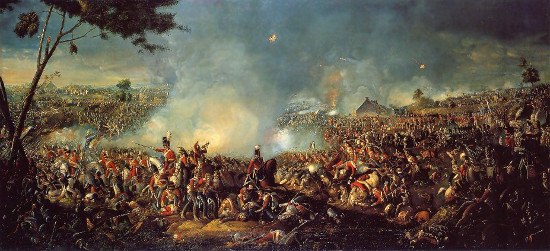by Björn Schöpe
March 26, 2015 – Every generation writes their history anew, that is nothing new as for the interpretation of history. Nations do this all the time, too. But what happens when the historical reading takes the shape of a coin designed to circulate in other nations as well?
William Sadler, Battle of Waterloo, before 1839.
Belgium planned to dedicate a 2 euro commemorative coin to the battle of Waterloo 200 years ago. Then Napoleon Bonaparte’s army was defeated thoroughly on modern Belgium’s territory. However, as 2 euro commemorative coins are legal tender in the whole Eurozone the Council of the European Union has to approve new designs. After all any other member state may object if the ‘draft design is likely to create adverse reactions among its citizens’.
Apparently Belgium did not expect any such objection because according to media reports it started minting the new coins in February even before Bruxelles approving of the design. But in a sharply-worded letter French President Hollande criticised the draft. He describes Belgium’s scheduled issue as ‘a symbol that is negative for a fraction of the European population’. The choice of the subject was very unfortunate – after all ‘the governments of the Eurozone are trying to strengthen unity and co-operation throughout the monetary union’.
The Council followed this view. And Belgium is stuck with 175,000 minted coins that cannot be issued as they are. Reportedly Belgium nevertheless still cherishes the subject and considers minting a coin on the battle of Waterloo with a different face value. By that modification the coins would become legal tender only in Belgium and other states would have no further say in the matter.
One may smile at the French because they are still so deeply affected by a battle of 200 years ago. One may wisecrack that it fits this image well that even in today’s France it is forbidden to give the name Napoleon to a pig. That, however, misunderstands the relevance which Europe attributes to the past. Ironically enough France had also planned to commemorate a battle numismatically, although it was, of course, a battle won by the French: Marignano.
Radical depiction of the battle of Marignano by the eyewitness Urs Graf, 1521.
Exactly 500 years ago a Swiss and a French army fought in a battle near Marignano in Lombardy for the Duchy of Milan. The Swiss lost because the armies of Bern, Solothurn, Fribourg and Valais had come to an arrangement with France and returned home without fighting. Thus Marignano does not only mark the end of Switzerland’s expansion but at least in the Swiss Confederation it is still seen as a painful symbol of Switzerland’s dissension.
According to a blog article by Stephen Clarke France ‘hastily … cancelled this project’ of a 2 euro commemorative coin. No one wanted to risk being critised for their veto over Belgium’s battle coin. In France, however, another view circulates: it is said that the French coin was scheduled for issue in June 2015 but that the Council rejected it already by the end of 2014 – that means months before the row over the Belgian coin. Nothing is known of an intervention by Switzerland.
Anyway we must appreciate that this time sensitivities of other nations have been considered before issuing new coins. Just remember of how much trouble caused Slovenia’s small 2 cent piece because it depicted the Prince’s Stone – which is also claimed by the Austrian region Carinthia as its oldest constitutional monument.
The letter of the French President was leaked to The Telegraph.
In Belgium media reported also on the Waterloo coin – from a slightly different point of view, though.
In Great Britain the whole row was described as a second battle of Waterloo.
CoinUpdate published an article on the French Marignano coin.
CGB writes on the subject in a different manner.






